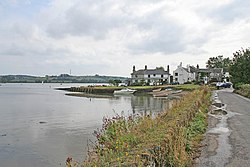Bere Ferrers
| Bere Ferrers | |
| Devon | |
|---|---|
 The Tavy at Bere Ferrers | |
| Location | |
| Grid reference: | SX4563 |
| Location: | 50°27’3"N, 4°10’34"W |
| Data | |
| Population: | 3,066 (2001) |
| Post town: | Yelverton |
| Postcode: | PL20 |
| Dialling code: | 01822 |
| Local Government | |
| Council: | West Devon |
| Parliamentary constituency: |
Torridge and West Devon |
Bere Ferrers is a village on the Bere Peninsula of west Devon. It had a population of 3,066 a t the 2001 census.
The village is on the broad, tidal reach of the River Tavy, immediately north of its joining the River Tamar, to the north of Plymouth. The Bere Peninsula is the triangle of land between the Tamar and the Tavy and Bere Ferrers is on the latter's western bank.
Bere Ferrers railway station on the Tamar Valley Line is nearby.
Parish church

The church of St Andrew has the oldest stained-glass window in Devon, excepting Exeter Cathedral; it is 600 years old. The building was probably built at various times between 1290 and 1340; it is recorded that an archpresbytery was founded here in 1333 and the north transept appears to be the earliest part of the church while the south aisle is the latest, perhaps 15th century.
Features of interest include the Norman font and benches whose bench-ends are carved with traceried arches, and an early mediæval monument to a knight and lady of the Ferrers family, who long owned the manor and gave it their name.
The church has an unusual feature of more recent times; the Lord of the Manor had a reserved pew in the north transept and here there is a fireplace (its chimney pierces the transept roof), and a squint carved through the masonry gives a view of the Communion Table from this pew.
In 1821 the antiquarian draughtsman Charles Alfred Stothard was killed in a fall while making a tracing from a window: his tombstone is in the churchyard.
Bench ends and bosses
The church contains late 15th-century oak pews with ornately carved bench ends. Two of these are of especially fine work and interest as they are carved with heraldic escutcheons of De Ferrers and Willoughby families.[1] Each is at the outer end of the central row of pews closest to the chancel. That on the north side shows a bend charged with 4 horseshoes (fer-de-cheval), being the canting arms of Ferrers, overlaid by 3 ship's rudders in bend sinister, the badge of the Willoughby family. That on the south side shows the arms of Willoughby de Broke.
The junctions of the oak beams of the ceiling of the south porch are embellished with several oak bosses, some of which display carved armorials of the ancestral families of Willoughby, namely De Ferrers, Latimer and Cheyne. Also appearing are the arms of the Gorges family of Knighton, Hampshire and Wraxall, Somerset.
References
Outside links
| ("Wikimedia Commons" has material about Bere Ferrers) |
References
- ↑ Rogers, pp.32–3
- Rogers, W.H. Hamilton, The Strife of the Roses and Days of the Tudors in the West, Exeter, 1890, pp. 1–36, Willoughby de Broke

